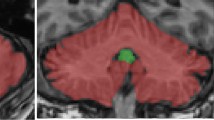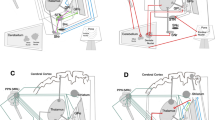Abstract
Introduction
Internal globus pallidus (GPi) deep brain stimulation (DBS) is a safe and effective alternative treatment in Parkinson’s disease (PD) for patients with cognitive impairment. However, no study has yet investigated metabolic changes within a large series of patients undergoing GPi stimulation.
Objective
We assessed motor, cognitive and psychiatric changes, as well as modifications in brain glucose metabolism measured with FDG-PET, before and after bilateral GPi-DBS.
Methods
In the same week, 32 patients with PD underwent a motor, cognitive and psychiatric assessment and a resting-state FDG-PET scan, 4 months before and 4 months after GPi-DBS surgery. For the voxelwise metabolic change assessment, the p value was controlled for multiple comparisons using the family wise error rate.
Results
After GPi-DBS surgery, patients showed a significant overall improvement in motor status. No cognitive or psychiatric changes were observed after surgery. Nor were any clusters with significantly relative metabolic changes found in the limbic circuit after surgery. Clusters with significantly relative metabolic changes were observed in the left and right Brodmann area (BA) 6, the right BA 9, the right and left BA 39 and the left BA 17.
Conclusion
The present study confirmed that GPi-DBS is an effective treatment in patients with advanced PD, owing to metabolic changes in the areas involved in motor execution. The absence of relative metabolic decrease in the limbic circuit and the few changes affecting the associative circuit could explain why GPi-DBS is cognitively safe.

Similar content being viewed by others
References
Krack P, Batir A, Van Blercom N, Chabardes S, Fraix V, Ardouin C, Koudsie A, Limousin PD, Benazzouz A, LeBas JF, Pollak P (2003) Five-year follow-up of bilateral stimulation of the subthalamic nucleus in advanced Parkinson’s disease. N Engl J Med 349:1925–1934
Parsons TD, Rogers SA, Braaten AJ, Woods SP, Troster AI (2006) Cognitive sequelae of subthalamic nucleus deep brain stimulation in Parkinson’s disease: a meta-analysis. Lancet Neurol 5:578–588
Volkmann J, Allert N, Voges J, Weiss PH, Freund HJ, Sturm V (2001) Safety and efficacy of pallidal or subthalamic nucleus stimulation in advanced PD. Neurology 56:548–551
Allert N, Volkmann J, Dotse S, Hefter H, Sturm V, Freund HJ (2001) Effects of bilateral pallidal or subthalamic stimulation on gait in advanced Parkinson’s disease. Mov Dis 16:1076–1085
Drapier D, Drapier S, Sauleau P, Haegelen C, Raoul S, Biseul I, Peron J, Lallement F, Reymann JM, Edan G, Verin M, Millet B (2006) Does subthalamic nucleus stimulation induce apathy in Parkinson’s disease? J Neurol 253:1083–1091
Funkiewiez A, Ardouin C, Caputo E, Krack P, Fraix V, Klinger H, Chabardes S, Foote K, Benbid AL, Pollak P (2004) Long term effects of bilateral subthalamic nucleus stimulation on cognitive function, mood, and behaviour in Parkinson’s disease. J Neurol Neurosurg Psychiatry 75:834–839
Bonenfant J, Drapier S, Houvenaghel JF, Naudet F, Haegelen C, Sauleau P, Vérin M (2017) Pallidal stimulation in Parkinson’s patients with contraindications to subthalamic target: a 3 years follow-up. Parkinsonism Relat Disord 34:20–25
Lachenmayer ML, Bettschen C, Bernasconi C, Petermann K, Debove I, Muellner J, Michelis JP, Burgunder JM, Krauss JK, Ortel MF, Pollo C, Kaelin-Lang A, Schüpbach M (2019) Stimulation of the globus pallidus internus in the treatment of Parkinson’s disease: long-term results of a monocentric cohort. Parkinsonism Relat Disord 64:118–123
Lozachmeur C, Drapier S, Robert G, Dondaine T, Laviolle B, Sauleau P, Peron J, Le Jeune F, Travers D, Millet B, Vérin M, Drapier D (2014) Pallidal stimulation in Parkinson’s disease does not induce apathy. J Neuropsychiatry Clin Neurosci 26:221–226
Rouaud T, Dondaine T, Drapier S, Haegelen C, Lallement F, Peron J, Raoul S, Sauleau P, Vérin M (2010) Pallidal stimulation in advanced Parkinson’s patients with contraindications for subthalamic stimulation. Mov Disord 25:1839–1846
Le Jeune F, Drapier D, Bourguignon A, Peron J, Mesbah H, Drapier S, Sauleau P, Haegelen C, Travers D, Garin E, Malbert CH, Millet B, Vérin M (2009) Subthalamic nucleus stimulation in Parkinson disease induces apathy: a PET study. Neurology 73:1746–1751
Le Jeune F, Peron J, Biseul I, Fournier S, Sauleau P, Drapier S, Haegelen C, Drapier D, Millet B, Garin E, Herry JH, Malbert CH, Vérin M (2008) Subthalamic nucleus stimulation affects orbitofrontal cortex in facial emotion recognition: a PET study. Brain 131:1599–1608
Le Jeune F, Peron J, Grandjean D, Drapier S, Haegelen C, Garin E, Millet B, Vérin M (2010) Subthalamic nucleus stimulation affects limbic and associative circuits: a PET study. Eur J Nucl Med Mol Imaging 37:1512–1520
Gibb WR, Lees AJ (1988) The relevance of the Lewy body to the pathogenesis of idiopathic Parkinson’s disease. J Neurol Neurosurg Psychiatry 51:745–752
Silberstein P, Bittar RG, Boyle R, Cook R, Coyne T, O'Sullivan D, Pell M, Peppard R, Rodrigues J, Silburn P, Stell R, Watson P (2009) Deep brain stimulation for Parkinson’s disease: Australian referral guidelines. J Clin Neurosci 16:1001–1008
Welter ML, Houeto JL, du Montcel ST, Mesnage V, Bonnet AM, Pillon B, Arnulf I, Pidoux B, Dormont D, Cornu P, Agid Y (2002) Clinical predictive factors of subthalamic stimulation in Parkinson’s disease. Brain 125:575–583
Fahn S, Elton R, UPDRS Development Committee (1987) Unified Parkinson’s disease rating scale. In: Fahn S, Marsden CD, Calne DB, et al. (eds) Recent developments in Parkinson’s disease. Macmillan, Florham Park, pp 153–163
Varrone A, Asenbaum S, Vander Borght T, Booij J, Nobili F, Nagren K, Darcourt J, Kapucu OL, Tatsch K, Bartenstein P, van Laere K, European Association of Nuclear Medicine Neuroimaging Committee (2009) EANM procedure guidelines for PET brain imaging using [18F]FDG, version 2. Eur J Nucl Med Mol Imaging 36:2103–2110
Meles SK, Renken RJ, Pagani M, Teune LK, Arnaldi D, Morbelli S, Nobili F, van Laar T, Obeso JA, Rodriguez-Oroz MC, Leenders KL (2020) Abnormal pattern of brain glucose metabolism in Parkinson’s disease: replication in three European cohorts. Eur J Nucl Med Mol Imaging 47:437–450
Asanuma K, Tang C, Ma Y, Dhawan V, Mattis P, Edwards C, Kaplitt MG, Feigin A, Eidelberg D (2006) Network modulation in the treatment of Parkinson’s disease. Brain 129:2667–2678
Geday J, Ostergaard K, Johnsen E, Gjedde A (2009) STN stimulation in Parkinson’s disease restores striatal inhibition of thalamocortical projection. Hum Brain Mapp 30:112–121
Hershey T, Revilla FJ, Wernle AR, McGee-Minnich L, Antenor JV, Videen TO, Dowling JL, Mink JW, Perlmutter JS (2003) Cortical and subcortical blood flow effects of subthalamic nucleus stimulation in PD. Neurology 61:816–821
Trost M, Su S, Su P, Yen RF, Tseng HM, Barnes A, Ma Y, Eidelberg D (2006) Network modulation by the subthalamic nucleus in the treatment of Parkinson’s disease. Neuroimage 31:301–307
Fukuda M, Mentis MJ, Ma Y, Dhawan V, Antonini A, Lang AE, Lozano AM, Hammerstad J, Lyons K, Koller WC, Moeller JR, Eidelberg D (2001) Networks mediating the clinical effects of pallidal brain stimulation for Parkinson’s disease: a PET study of resting-state glucose metabolism. Brain 124:1601–1609
Greuel A, Pauls KAM, Koy A, Sudmeyer M, Schnitzler A, Timmermann L, Fink GR, Eggers C (2020) Pallidal deep brain stimulation reduces sensorimotor cortex activation in focal/segmental dystonia. Mov Disord 35(4):629–639
Parent A, Hazrati LN (1995) Functional anatomy of the basal ganglia. II. The place of subthalamic nucleus and external pallidum in basal ganglia circuitry. Brain Res Brain Res Rev 20:128–154
Yelnik J (2002) Functional anatomy of the basal ganglia. Mov Disord 17(Suppl 3):S15–21
Haegelen C, Baumgarten C, Houvenaghel JF, Zhao Y, Peron J, Drapier S, Jannin P, Morandi X (2018) Functional atlases for analysis of motor and neuropsychological outcomes after medial globus pallidus and subthalamic stimulation. PLoS ONE 13:e0200262
Acknowledgements
The authors would like to thank Elizabeth Wiles-Portier, a native speaker, for editing the manuscript for nonintellectual content.
Author information
Authors and Affiliations
Corresponding author
Ethics declarations
Conflicts of interest
Sophie Drapier received speech honoraria from Teva and Medtronic, and served on scientific advisory boards for Aguettant, Orkyn and Britannia. Gabriel Robert received travel support for scientific communications from Johnson & Johnson and Otsuka-Lundbeck. All other authors declare no financial conflicts of interest.
Ethical standard statement
The present study received approval from the local Ethical committee of the University Hospital of Rennes. After a complete description of the study, written informed consent was obtained from each patient.
Rights and permissions
About this article
Cite this article
Palard-Novello, X., Drapier, S., Bonnet, A. et al. Deep brain stimulation of the internal globus pallidus does not affect the limbic circuit in patients with Parkinson’s disease: a PET study. J Neurol 268, 701–706 (2021). https://doi.org/10.1007/s00415-020-10212-y
Received:
Revised:
Accepted:
Published:
Issue Date:
DOI: https://doi.org/10.1007/s00415-020-10212-y




